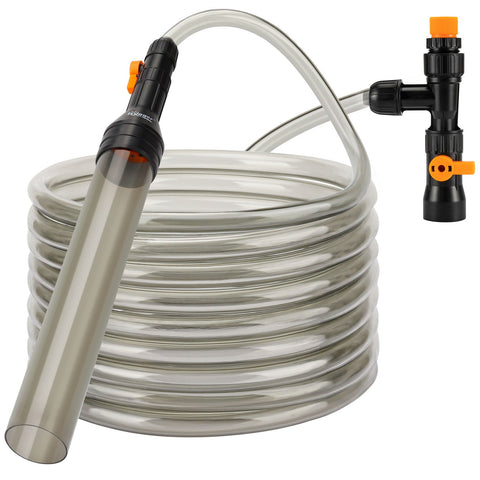Tannins are acidic compounds produced by decay plants and driftwood in the fish tank. They will dissolve in water and make your fish tank look yellow or brown.
Moderate tannins in a fish tank can help lower the pH level, but if they are excessive, the fish in your tank will feel uncomfortable and your aquarium will lose its ornamental value.
In this article, you’ll know what brings tannins to your aquarium, the advantages and disadvantages of tannins, how to remove them and which kind of fish can survive in water containing a lot of tannins. Keep reading and know more about tannins!
Why there are tannins in your fish tank?
Before getting to know the methods of removing the tannins in your fish tank, you need to figure out why there are tannins in it. There are 3 causes of the excessive tannins in your fish tank- fish waste, decay plants and driftwood.
Fish waste
Fish waste includes their ordure, dead bodies and uneaten food. It is unavoidable if you keep fish in your aquarium. If you have read our former blogs, you’ll fish waste will bring nitrate and ammonia to your fish tank, which is detrimental to the water quality and fish health. Now, in this article, we’ll tell you that it will also produce tannins.
Decay plants
Tannins survive in organic matter, which includes decay plants. They are the dead bodies of the plants, which are the decorations of your fish tank. If you don’t remove the decay plants in your fish tank once you find them, they will produce tannins in your fish tank and influence the pH level.
Driftwood
In the blog “Do You Need to Boil Driftwood”, we have mentioned that the driftwood contains a lot of tannins, which is one of the reasons why you should boil the driftwood. So it is on the list of things that bring tannins to your fish tank.
The effects of tannins
Have you ever heard “One's honey is another's arsenic”? I think this proverb is a perfect illustration of the effects that tannins have on different fish. For fish that require a lower pH level, tannins are honey, but for fish that can not bear an acidic environment, they will be arsenic.
Tannins can help fish breed and shorten the gestation period of a pregnant fish and prevent the growth of algae, so you will not have a green tank. They will also prolong the lifespan of the creatures in your tank. But excessive tannins will affect the water parameters in your tank and make your tank look ugly.
How to remove excessive tannins from your aquarium?
Now we can start talking about measures you can take to remove tannins from your aquarium since you have known what are they and the causes of them. There are several suggestions for you.
1. Use activated carbon
Activated carbon is one type of filter media that can neutralize the acid in your fish tank. Most filters contain this sort of filter media, you don’t need to buy extra activated carbon if you’ve already got such a filter for your fish tank. If you don’t have an activated carbon filter, you can buy one from the store or online, but make sure you choose the best one for your fish.
2. Soak or boil the driftwood before using
Driftwood is one of the sources of tannins, so if you want to remove the tannins, you can start by soaking or boiling the driftwood. It can also help make the driftwood fully waterlogged so it can fall to the bottom of the fish tank once being put in.
Soak the driftwood in treated water and change the water when it turns turbid. When the water stays clean, you can finish this process. And boiling is more efficient than soaking since molecules move faster at high temperatures. The boiling process can also help sterilize the driftwood.
3. Remove the fish waste in time
Just like driftwood, fish waste will also cause excessive tannins in a fish tank. And it’s simple for you to remove dead things and uneaten food from your aquarium, all you need is to find a tool and fish out them.
You can also keep some creatures such as snails that eat fish waste, but I’ll recommend you choose the first one unless you want to make your fish tank more diversified in creatures since keeping them is not so easy.
4. Use chemicals to neutralize the acid
Actually, I don’t suggest you use chemicals to neutralize the acid because some chemicals will stay in your fish tank and do harm to your fish’s health. But it is still a useful way to remove tannins in your fish tank.
If you decide to use this method, I hope you can make sure the chemicals have been eliminated before you put your fish back in the aquarium.
5. Do a regular water change
This might be the most troublesome but also most efficient method. Other measures are not able to remove the tannins thoroughly, but water change can.
So, although it takes a lot to change the water in your fish tank, you need to do it regularly, not only for removing tannins but also for clearing out other harmful elements from your fish tank to provide your fish with a stable and healthy environment.
Although it’s more difficult to remove the tannins by changing water, you can try to make it simpler with some useful tools. I’ll recommend you use a water changer, which can also help you clean the substrate, if you have it, in your aquarium.
With this tool, you can avoid wet hands while changing the water and cleaning the tank. We have an article that mainly talks about how to change fish tank water, if you have no idea of how to do a water change, try to read and follow the instructions.

What types of fish need tannins?
Removing excessive tannins in your tank is necessary, but sometimes, they are also very useful for some fish. If you are keeping the following fish, you need to leave some tannins in your aquarium.- Tetras: Neon tetra, Lemon tetra, Ember tetra and so on.
- Cichlids: Oscars, Angelfish, Discus and so on.
- Catfish: Cory catfish, Electric catfish, Dwarf suckers, etc.
Conclusion
Will tannins kill your fish? They won’t, but they do influence the environment in the fish tank. And if you can’t bear the color caused by tannins, it will bother you.
This article has provided some methods for you to remove the tannins from your aquarium, but I can not make sure you can eliminate them since most things in your aquarium will produce tannins. And that’s why I suggest that you make removing tannins a regular task.
One thing you need to keep in mind is that you need to pay attention to the pH level while you clean the tannins in case the sudden change in acid shocks your fish.


Comments (0)
Back to Aquarium Maintenance